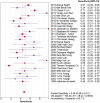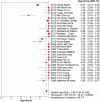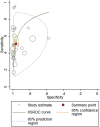Diagnostic Value of Vestibular Evoked Myogenic Potentials in Endolymphatic Hydrops: A Meta-Analysis
- PMID: 26455332
- PMCID: PMC4601069
- DOI: 10.1038/srep14951
Diagnostic Value of Vestibular Evoked Myogenic Potentials in Endolymphatic Hydrops: A Meta-Analysis
Abstract
In this study, we evaluated the clinical diagnostic value of vestibular evoked myogenic potentials (VEMPs) for endolymphatic hydrops (EH) by systematic review and Meta-analysis. The pooled sensitivity, specificity, positive likelihood ratio, negative likelihood ratio, diagnostic odds ratio and area under summary receiver operating characteristic curves (AUC) were calculated. Subgroup analysis and publication bias assessment were also conducted. The pooled sensitivity and the specificity were 49% (95% CI: 46% to 51%) and 95% (95% CI: 94% to 96%), respectively. The pooled positive likelihood ratio was 18.01 (95% CI: 9.45 to 34.29) and the pooled negative likelihood ratio was 0.54 (95% CI: 0.47 to 0.61). AUC was 0.78 and the pooled diagnostic odds ratio of VEMPs was 39.89 (95% CI: 20.13 to 79.03). In conclusion, our present meta-analysis has demonstrated that VEMPs test alone is not sufficient for Meniere's disease or delayed endolymphatic hydrops diagnosis, but that it might be an important component of a test battery for diagnosing Meniere's disease or delayed endolymphatic hydrops. Moreover, VEMPs, due to its high specificity and non-invasive nature, might be used as a screening tool for EH.
Figures






Similar articles
-
Positive pressure therapy for Ménière's disease or syndrome.Cochrane Database Syst Rev. 2015 Mar 10;2015(3):CD008419. doi: 10.1002/14651858.CD008419.pub2. Cochrane Database Syst Rev. 2015. PMID: 25756795 Free PMC article.
-
Signs and symptoms to determine if a patient presenting in primary care or hospital outpatient settings has COVID-19.Cochrane Database Syst Rev. 2022 May 20;5(5):CD013665. doi: 10.1002/14651858.CD013665.pub3. Cochrane Database Syst Rev. 2022. PMID: 35593186 Free PMC article.
-
Systematic review of the diagnostic value of hydrops MRI in relation to audiovestibular function tests (electrocochleography, cervical vestibular evoked myogenic potential and caloric test).Eur Arch Otorhinolaryngol. 2023 Mar;280(3):947-962. doi: 10.1007/s00405-022-07702-2. Epub 2022 Oct 27. Eur Arch Otorhinolaryngol. 2023. PMID: 36301356 Free PMC article.
-
[Diagnosis of labyrinth hydrops in patients on different stages of Meniere's disease].Vestn Otorinolaringol. 2025;90(3):24-29. doi: 10.17116/otorino20259003124. Vestn Otorinolaringol. 2025. PMID: 40530836 Russian.
-
Diagnostic test accuracy of nutritional tools used to identify undernutrition in patients with colorectal cancer: a systematic review.JBI Database System Rev Implement Rep. 2015 May 15;13(4):141-87. doi: 10.11124/jbisrir-2015-1673. JBI Database System Rev Implement Rep. 2015. PMID: 26447079
Cited by
-
Cervical VEMP tuning changes by Meniere's disease stages.Laryngoscope Investig Otolaryngol. 2019 Sep 18;4(5):543-549. doi: 10.1002/lio2.309. eCollection 2019 Oct. Laryngoscope Investig Otolaryngol. 2019. PMID: 31637299 Free PMC article.
-
Investigation of Vestibular Function in Adult Patients with Gitelman Syndrome: Results of an Observational Study.J Clin Med. 2020 Nov 23;9(11):3790. doi: 10.3390/jcm9113790. J Clin Med. 2020. PMID: 33238651 Free PMC article.
-
Concurrent superior semicircular canal dehiscence and endolymphatic hydrops: A novel case series.Int J Surg Case Rep. 2021 Jan;78:382-386. doi: 10.1016/j.ijscr.2020.12.074. Epub 2020 Dec 26. Int J Surg Case Rep. 2021. PMID: 33421957 Free PMC article.
-
Optimizing staging of Meniere's disease: integrating electrocochleography with vestibular tests.Front Neurosci. 2025 Jul 8;19:1600665. doi: 10.3389/fnins.2025.1600665. eCollection 2025. Front Neurosci. 2025. PMID: 40697275 Free PMC article.
-
Menière's Disease and Caloric Stimulation: Some News from an Old Test.J Int Adv Otol. 2019 Dec;15(3):442-446. doi: 10.5152/iao.2019.7430. J Int Adv Otol. 2019. PMID: 31846926 Free PMC article.
References
-
- Committee on Hearing and Equilibrium guidelines for the diagnosis and evaluation of therapy in Meniere’s disease. American Academy of Otolaryngology-Head and Neck Foundation, Inc. Otolaryngol Head Neck Surg 113, 181–185(1995). - PubMed
-
- Paparella M. M. Pathogenesis of Meniere’s disease and Meniere’s syndrome. Acta Otolaryngol Suppl. 406, 10–25 (1984). - PubMed
-
- Hamid M. A. Meniere’s disease. Pract Neurol. 9, 157–62 (2009). - PubMed
-
- Schukneht H. F. Delayed endolymphatic hydrops. Ann Otolaryngol. 87, 743–748 (1978). - PubMed
-
- Minor L. B., Schessel D. A. & Carey J. P. Meniere’s disease. Curr Opin Neurol. 17, 9–16 (2004). - PubMed
Publication types
MeSH terms
LinkOut - more resources
Full Text Sources
Other Literature Sources
Medical

